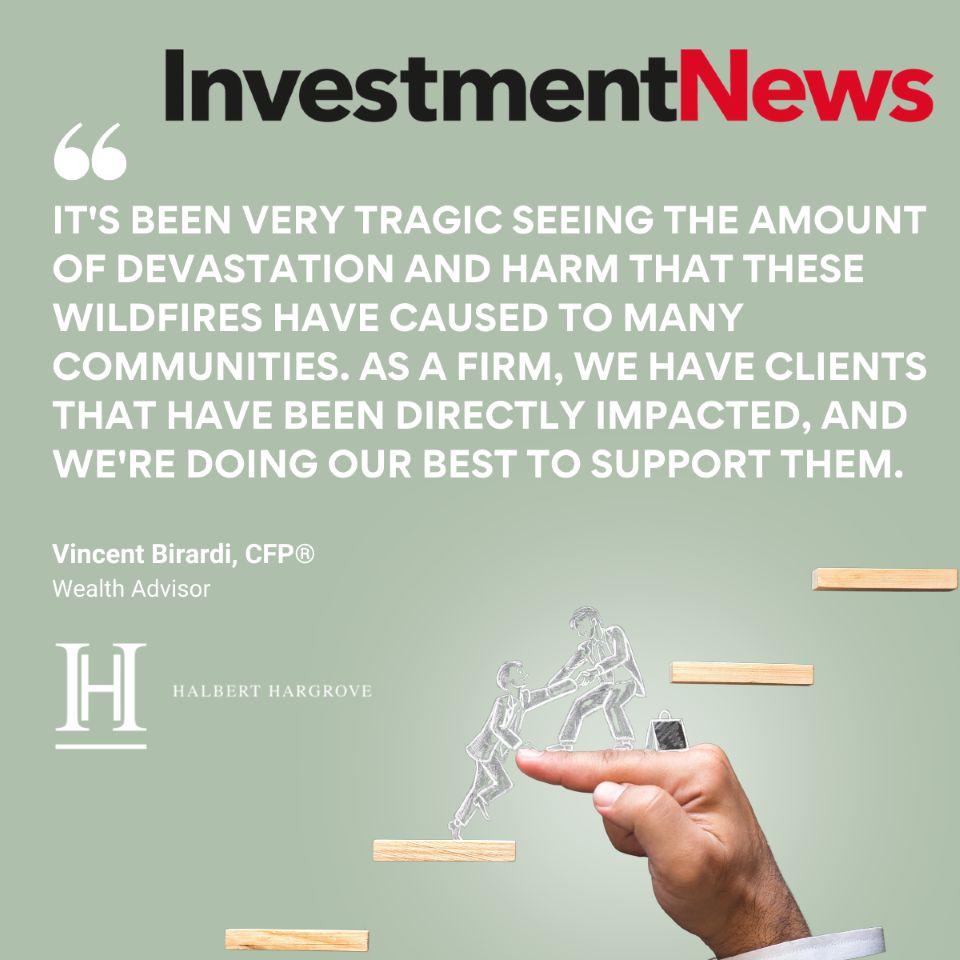By Leo Almazora in InvestmentNews, featuring Vincent Birardi, CFP®, AIF®, Wealth Advisor
As firefighters and other first responders continue the battle to contain historic wildfires in Southern California, advisors are also doing their part to help.
While the financial and economic toll from the disasters continues to mount, financial advisors in the area have been pulling extra hours to reach clients, many of whom found their lives suddenly turned upside-down.
“It’s been very tragic seeing the amount of devastation and harm that these wildfires have caused to many communities,” said Vincent Birardi, wealth advisor at Halbert Hargrove. “As a firm, we have clients that have been directly impacted, and we’re doing our best to support them.”
Andrew Crowell, who’s the vice chairman for wealth management at DA Davidson, has also been working overtime to support clients at the LA-based firm. Apart from helping families cope, he has been offering advice to well-intentioned individuals who want to offer financial aid through charitable giving.
“Many people don’t realize that you can actually make a qualified charitable distribution from your IRA,” he said. “It counts towards meeting the required minimum distribution.”
According to Crowell, many of his elderly clients living on a fixed income wait until the December deadline before taking out their RMDs. The fact that they make those withdrawals at the last minute, rather than periodically throughout the year, suggests they had other income sources to support their needs in retirement.
“You have Uncle Sam saying, ‘Oh, but you’ve got to take this money out every year,'” Crowell said. “If someone has a massive RMD each year of $100,000 to $200,000, half of that can go to charity, which is a huge benefit for those who don’t need that money to live on.”
Those looking to give via a QCD, Birardi cautioned, should be mindful of the maximum amount they can declare in a given year. Historically, the annual limit for QCDs was $100,000, but since it’s been indexed to inflation, the ceiling for individual QCDs has gone up to $105,000 for 2025.
“There’s no limit to the number of organizations to whom someone in RMD mode can give…. It more comes down to the logistics,” he added. “If you want to make $20,000 donations to five different organizations, you have to coordinate with them, and understand their giving process…. Some will ask to receive funds electronically. Others are fine receiving a physical check.”
Individuals making QCDs to different entities, Birardi said, should also maintain adequate documentation. Building an audit trail with details around donations, including the amounts involved and where they went, is essential to prepare for the end-of-year RMD tax filing process.
For those who aren’t in RMD mode, he said donor-advised funds are another beneficial option. While RMDs are only a factor for IRA investors starting at age 73, Birardi noted that DAFs are an option to any adult investor.
“It’s way to make charitable donations to worthy non-profit organizations. And in doing so, as the donor, you’re also benefiting from a tax mitigation perspective,” he said.
For many investors, having a DAF account is part of a broader philanthropic strategy that includes both planned long-term support for specific causes and spontaneous donations to unexpected events like natural disasters. Those using DAFs for that mixed approach, as opposed to just sticking to planned-out philanthropy, tend to give more, according to one 2024 study from Vanguard Charitable.
Earlier this month, the American College of Financial Services announced it was launching a DAF professional certification program. With support from Fidelity Charitable, National Philanthropic Trust, Vanguard Charitable, and DAFgiving360, the college said it “aims to empower staff at DAF-sponsoring organizations to create a shared standard of knowledge and competency for the DAF industry.”
Amid the broad outpouring of generosity in recent weeks, there’s also been a proliferation of online wildfire scams. To protect his clients, Crowell said he’s been warning them against fake GoFundMe accounts, phishing emails, and other fraudulent links designed to steal people’s personal or financial information.
“This is a time you want every dollar to go to relief, and you don’t want to be taken advantage of by a scammer,” he said. “We’re encouraging people to take a deep breath. If you want to give to an organization and can’t go to them directly, try to find their legitimate website.”
For Birardi, it’s also important to make sure clients are keeping their other financial priorities in mind.
“I think as human beings, we want to help others, which is a wonderful impulse to have,” he said. “But we also have to fund a client’s cost of living or satisfy other goals that they may have. So it’s basically trying to work in this desire alongside other goals a client and myself may have already agreed to.”


